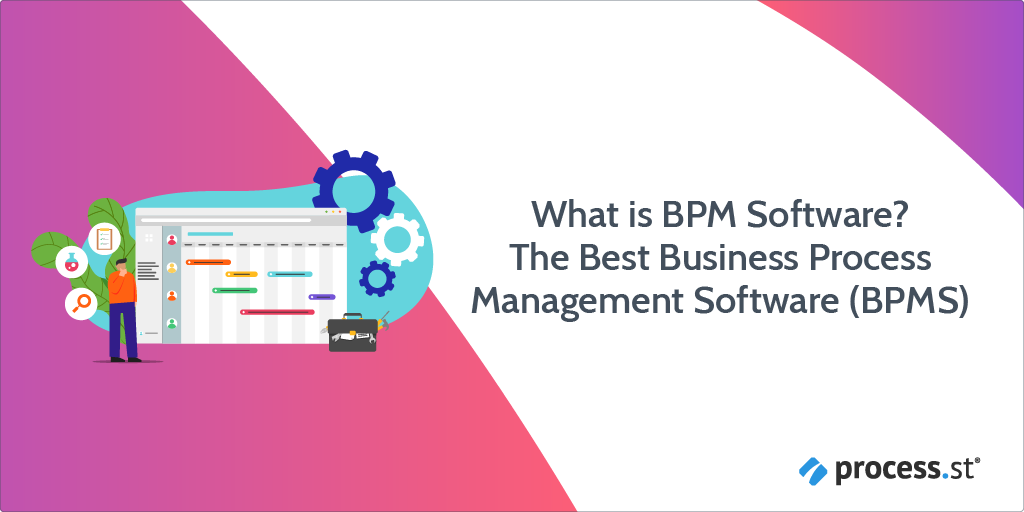
This is a big blog post about Business Process Management software (BPMS). If I’ve succeeded in doing what I set out to do, this article should provide pretty much everything you could ever need to know about BPM software.
At its core, the article is built around the following pillars of BPM software:
- Top BPM software
- BPM basics: The idea behind it
- BPM in practice: How to use it
- A glossary of BPM terms
- Use cases of BPM software
- Using Process Street for BPM
I have tried to distil the information in this article to only the most crucial elements, and many sections have been abbreviated where they deserve entire articles to themselves!
Thankfully, where necessary I have provided links to supporting material where these concepts are expanded upon, should you be interested in delving deeper.
So, this article is about BPM software. What’s the current outlook on BPM as a whole?
Let’s begin with some statistics to whet your appetite:
According to this report:
- The global BPM market accounted for $7.34 billion in 2017 and is expected to grow at a CAGR of 15.5% to hit $26.76 billion by 2026.
- Increased call for cost efficiency and a demand for automation to lower product or service costs are the driving forces of BPM market growth.
- Significant growth has been forecast in the banking, financial services and insurance (BFSI) sectors, which are adopting BPM solutions for process improvements in order to aid institutions in targeting and serving customers better.
- North America has the largest market share growth thanks to a large number of BPM vendors such as Pega, IBM and Oracle that are based in the US.
Statistics are all well and good, but what is BPM all about, really?
We’ll get to that, but first, a handy list of the top BPM software, for those of you who’d rather get straight to the point:
Top BPM software
Process Street
![]()
Process Street is a powerful business process management tool that simplifies workflow automation. It enables organizations to create, track, and optimize recurring processes through intuitive checklists. With features like conditional logic and AI-generated workflows, Process Street enhances efficiency, accountability, and collaboration, making it an invaluable tool for businesses striving for operational excellence.
Key features:
- Checklist automation: Create and automate dynamic checklists for recurring processes.
- Conditional logic: Customize workflows with conditional logic based on responses.
- Custom workflows: Facilitate team collaboration on tasks and processes.
- Integration capabilities: Seamlessly integrate with tons of apps and tools.
- Task assignment: Assign and track responsibilities within processes.
- Data collection: Gather and store data through forms within checklists.
- Reporting and analytics: Generate insights with analytics on process performance.
- Version control: Maintain and track versions of checklists for auditing.
- API access: Connect with other applications through APIs.
- Document storage: Attach and manage documents relevant to processes.
Pros:
- Intuitive interface makes it user-friendly.
- Offers secure data handling and storage.
- It has a mobile business application.
- Custom automated workflows can be made with AI.
- It has lots of premade workflow templates to choose from.
- Great for employee onboarding.
- It makes communication between team members super simple.
- It has excellent analytics features.
- It offers lots of third-party integrations.
- It makes daily operations so much easier.
Cons:
- There is no free plan.
Monday.com

Monday.com is a dynamic work operating system designed to streamline collaboration and project management. It provides a visual and customizable platform for teams to manage tasks, projects, and workflows efficiently. Monday.com helps teams enhance communication and productivity while adapting to diverse work processes.
Key features:
- Workspaces: Create customized workspaces for different projects.
- Boards: Visualize tasks and projects through customizable boards.
- Pulses: Individual task cards with detailed information.
- Timeline view: Display project timelines for better planning.
- Automations: Streamline workflows with automated actions.
Pros:
- Attach and share files directly within the platform.
- Real-time collaboration with team members.
- Create and customize visual dashboards for insights.
- Responsive customer support for assistance.
Cons:
- The free plan has very limited features.
- It doesn’t offer an offline mode.
iGrafx

iGrafx is a comprehensive platform for business process management that enables organizations to optimize processes and enhance efficiency. It empowers users to model, analyze, and improve workflows, fostering a deeper understanding of operations.
Key features:
- Process modeling: Creates visual representations of business processes.
- Process optimization: Identifies areas for improvement within workflows.
- Process documentation: Documents and maintains process details.
- Process simulation: Simulates processes for performance testing and improvement.
- Process governance: Ensures compliance and adherence to standards.
Pros:
- Maps out detailed workflows for clarity and analysis.
- Monitors ongoing processes for performance evaluation.
- Manages changes to processes and tracks their impact.
- Implements governance frameworks for process management.
Cons:
- It’s not good for freelancers or small businesses.
- The interface has a steep learning curve.
Tallyfy

Tallyfy is a transformative process management platform designed to simplify workflows and boost productivity. With its intuitive interface and powerful capabilities, Tallyfy empowers teams to streamline processes, drive efficiency, and achieve operational excellence seamlessly across diverse industries and sectors.
Key features:
- Customizable templates: Utilizes pre-built templates or create custom templates to standardize processes.
- Data security: Implements measures to protect sensitive information and ensure compliance with data regulations.
- Workflow automation: Automates repetitive tasks and processes to save time and increase efficiency.
- Visual process mapping: Designs and visualizes workflows using a drag-and-drop interface.
Pros:
- Sends automated alerts and reminders for pending tasks, approvals, and deadlines.
- Ensures processes adhere to regulatory standards and industry best practices.
- Prioritizes tasks based on urgency and importance to focus efforts effectively.
Cons:
- It has no offline capabilities.
- It’s better suited for simple tasks.
ProWorkflow

ProWorkflow simplifies project management, offering a versatile platform for teams. Emphasizing efficiency and collaboration, it streamlines workflows while ensuring adaptability to diverse project needs. It allows seamless task handling and organized project oversight, making it a cornerstone for successful project completion.
Key features:
- Task management: Assigns, tracks, and manages tasks efficiently.
- Time tracking: Monitors time spent on tasks for accurate billing and analysis.
- Collaboration tools: Facilitates team communication and collaboration.
- Project templates: Offers pre-built templates for quick project setup.
- Gantt charts: Visualizes project timelines and dependencies.
Pros:
- Allows seamless sharing and storage of project files.
- Manages and allocates resources effectively.
- Tracks project-related expenses for budgeting.
- Generates invoices and manages billing processes.
Cons:
- Contractors can’t track time in the software.
- It’s not as rich in features as other products.
Zoho Creator

Zoho Creator is a robust no-code platform allowing users to build tailored applications to streamline business processes. It fosters seamless automation and data management. This versatile tool caters to diverse needs, offering dynamic solutions for efficient workflow orchestration across industries.
Key features:
- Calendar and scheduler: Plan and organize tasks and events.
- Custom reports: Generate tailored reports as needed.
- Geolocation and maps: Integrate maps and location-based features.
- App building: No-code platform to create custom applications.
Pros:
- Automates and streamlines business processes.
- Centralizes and manages data efficiently.
- Tracks activities for compliance and analysis.
Nintex

Nintex streamlines business processes with intuitive automation solutions, empowering organizations to achieve operational efficiency and agility. Through user-friendly tools, it simplifies complex workflows, fostering collaboration and accelerating productivity.
Key features:
- Workflow automation: Enables the creation of automated workflows without coding.
- Forms and mobile apps: Offers easy creation of forms and mobile apps.
- Integration connectors: Provides a wide array of connectors for seamless integration.
- Process mapping and visualization: Visual tools for mapping out and understanding complex processes.
- Document generation: Automates the creation of documents within workflows.
Pros:
- Offers advanced analytics to track, measure, and optimize workflows, identifying areas for improvement.
- Ensures compliance with regulatory standards and governance policies.
- Provides pre-built templates for common processes.
Cons:
- It’s very expensive.
Appian BPM Suite

Appian serves as a robust low-code automation platform, empowering businesses to rapidly build, deploy, and manage powerful applications. Its focus on speed and simplicity enables process managers to adapt swiftly to market changes, fostering innovation and agility.
Key features:
- Low-code development: Enables rapid app development with minimal coding.
- Process modeling: Intuitive tools for modeling and automating complex processes.
- Business rules management: Configurable rules for decision-making within applications.
- User experience design: Intuitive interfaces for user-friendly experiences.
- Case management: Manages cases efficiently within applications.
Pros:
- Offers a free plan.
- Offers cloud-based deployment options.
- Manages and integrates content within applications.
- Provides actionable insights using AI capabilities.
Cons:
- The ability to customize features is limited.
- It can sometimes struggle to handle large amounts of data.
ProcessMaker

ProcessMaker is a leading workflow automation platform, known for its user-friendly interface and adaptability. It emphasizes streamlining processes, optimizing productivity, and facilitating collaboration. Its focus on intuitive design and flexibility empowers organizations to orchestrate complex workflows seamlessly, fostering innovation and operational efficiency.
Key features:
- Workflow automation: Automate and streamline complex business processes without manual intervention.
- Drag-and-drop interface: Intuitive interface for building workflows and forms visually.
- Form builder: Easily create custom forms tailored to specific business needs.
- Integration capabilities: Integrate with various third-party applications and systems.
- Task management: Assign, monitor, and manage tasks within workflows efficiently.
Pros:
- Centralizes storage and management of documents within processes.
- Details logs tracking all activities within workflows for compliance and analysis.
- Routes tasks based on predefined criteria or decisions.
Cons:
- It has somewhat frequent bugs that can be disruptive.
Celonis
![]()
Celonis is a leading process mining and execution management software company. It helps organizations visualize, analyze, and improve their business processes. By leveraging real-time data and advanced analytics, Celonis identifies inefficiencies and optimizes workflows, driving operational excellence and significant cost savings across various industries.
Key features:
- Process mining: Analyzes business processes based on event logs to provide a visual representation of process flows.
- Real-time data integration: Connects to multiple data sources for real-time analysis and monitoring.
- Process visualization: Creates detailed process maps to identify bottlenecks and inefficiencies.
- Root cause analysis: Identifies the underlying causes of process deviations and inefficiencies.
- KPI monitoring: Tracks key performance indicators to measure process performance and effectiveness.
Pros:
- Recommends and automates actions to optimize processes based on insights.
- Simulates process changes to predict outcomes and assess potential improvements.
- Compares process performance against industry standards and best practices.
- Ensures processes adhere to regulatory requirements and internal policies.
Cons:
- It’s quite expensive.
- It has a pretty steep learning curve.
Bizagi

Bizagi redefines business process software with a focus on innovation and agility. It fosters collaboration and adaptability. By prioritizing user-centric design and flexible solutions, Bizagi facilitates efficient process automation, enabling businesses to thrive in dynamic and competitive landscapes.
Key features:
- Process modeling: Creates and designs workflows visually.
- Workflow automation: Automates and executes business processes.
- Rule engine: Manages and implements business rules within workflows.
- Process simulation: Simulates processes for optimization and testing.
- Adaptive case management: Handles unstructured and dynamic processes.
Pros:
- Automates routine tasks within workflows.
- Identifies and optimizes inefficient processes.
- Manages and resolves errors within workflows.
- Implements security protocols to protect sensitive data.
Cons:
- The process documentation feature is not enterprise-ready.
- The pricing plan is not a subscription model.
LucidChart

Lucidchart is a versatile cloud-based platform known for its intuitive interface, enabling seamless creation of diagrams and visual representations. Renowned for collaborative capabilities, it facilitates team brainstorming and process mapping. Its adaptability across industries makes it a go-to choice for illustrating complex concepts and workflows.
Key features:
- Shape libraries: Extensive libraries for symbols and shapes.
- Diagram creation: Tools for creating flowcharts, mind maps, org charts, etc.
- Presentation mode: Ability to present diagrams.
- Collaborative editing: Simultaneous editing by multiple users.
- Revision history: Track changes made to diagrams.
Pros:
- Ability to link shapes and objects.
- Embed diagrams in websites or documents.
- Capability to work on diagrams offline.
- Ability to customize colors, fonts, and styles.
Cons:
- There is an object limit in the free version.
Zapier

Zapier is an automation tool that streamlines workflows and integrations for sales teams. It automates repetitive tasks across various apps, enhancing efficiency. Zapier empowers sales automation by enabling teams to focus on core tasks for increased productivity.
Key features:
- Integration hub: Connects diverse apps to streamline data flow and processes.
- Trigger-action system: Sets triggers to initiate actions between connected apps.
- Multi-step Zaps: Executes multiple actions across various apps in a sequence.
- Conditional logic: Sets conditions to trigger specific actions based on criteria.
- Scheduled tasks: Automates tasks based on predefined schedules.
Pros:
- Automates repetitive tasks between different apps without coding.
- Connects with CRM systems and sales tools for sales process automation.
- Allows creating custom Zaps tailored to specific needs.
- Provides insights into Zap performance and execution.
Cons:
- It takes time to learn how to use Zaps effectively.
- Users have reported poor customer support.
Oracle BPM Suite
![]()
Oracle BPM Suite is a comprehensive business process management solution designed to optimize and automate business workflows. It provides tools for modeling, executing, and monitoring processes, enabling organizations to improve efficiency, ensure compliance, and drive innovation. The suite integrates seamlessly with Oracle’s other enterprise applications for enhanced functionality.
Key features:
- Process modeling: Creates detailed process models using BPMN (Business Process Model and Notation) standards.
- Process simulation: Simulates processes to predict outcomes and identify potential improvements.
- Process automation: Automates routine tasks to enhance efficiency and reduce manual intervention.
- Workflow management: Manages and optimizes workflows across different departments and systems.
- Business rules engine: Defines and manages business rules to drive process logic and decision-making.
Pros:
- Identifies bottlenecks and inefficiencies to continually optimize business processes.
- Manages tasks and activities within business processes effectively.
- Handles complex, unstructured processes that require human intervention and decision-making.
- Provides security measures to protect data and ensure compliance with data regulations.
Cons:
- It really only integrates with other Oracle products.
Wrike

Wrike is a robust project management and collaboration platform designed to streamline workflows and enhance team productivity. Its dynamic interface and flexible structure cater to diverse project needs, fostering efficient communication and project coordination. Wrike empowers teams to manage tasks, projects, and resources seamlessly for successful project outcomes.
Key features:
- Time tracking: Monitor and analyze time spent on tasks and projects.
- Resource management: Allocate and manage team resources effectively.
- Task management: Organize and prioritize tasks efficiently.
- Project planning: Plan and visualize projects with timelines and Gantt charts.
- Collaboration: Facilitate real-time collaboration and communication.
Pros:
- Efficient allocation and management of team resources.
- Convenient file sharing and collaboration within the platform.
- Adaptable to various project management needs.
- Seamless integration with numerous third-party apps.
Cons:
- Basic features in the free plan may be insufficient for larger teams.
- Can be resource-intensive in terms of memory and processing.
Now that that’s over and done with, we can begin by easing ourselves into the basics of BPM.
BPM basics: The idea behind it
In a nutshell, business process management is an umbrella term for the many different ways a company creates, analyzes, and updates all of the processes that drive work in the business.
Different departments within a company are responsible for following and maintaining their own processes. There may be a dozen or more core processes that each department handles.
With business process management, the idea is to take a step back and look at all of the different processes, from every perspective; both as a whole and as individual processes. By analyzing the current state of the processes being used, areas of improvement can be identified in order to achieve a more efficient and effective organization.
What is BPM?
Business process management = creating and optimizing the ideal plans to achieve your business goals.
It’s not simply a technology, or a one time thing. You don’t ever consider your processes ‘fully managed’ or optimized. BPM is a continuous process: whether or not someone in the company has it in their job title or description, business processes are in a constant state of flux. BPM is constantly tweaking and challenging current operations.
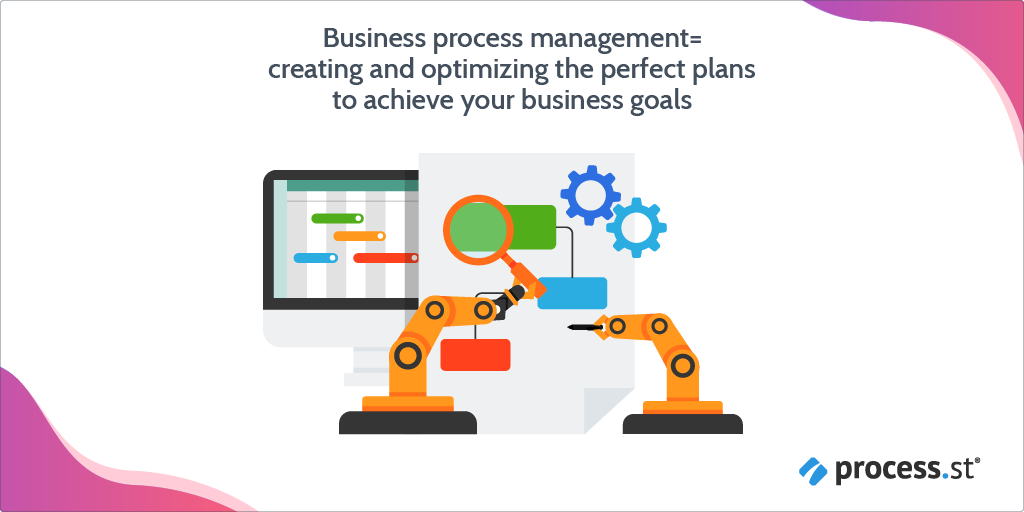
In short, BPM is a methodology summed up by the idea of running an organization via processes.
This methodology differs depending on whether you’re a big or small organization, but BPM is equally useful for organizations at all scales. What’s different is the kind of BPM solution required to solve different kinds of problems faced at different scales.
Why use BPM?
When considering why you might want to use BPM, the following four core business drivers are common motivators for the adoption of BPM.
Improving a process or sub-process
Companies use BPM to improve processes.
These are not usually complete process frameworks or workflows, but sub-processes within a workflow. In these cases, BPM is able to find solutions faster. This also serves as a pilot to a first experience with BPM.
BPM(S) for Continuous Process Improvement (CPI)
BPM and Continuous Process Improvement methodologies like Lean, Six Sigma, SCOR, TQM, and so on are extremely compatible, and many companies who have embarked on a CPI initiative implement a business process management suite (BPMS) as the technology companion and enabler to their CPI program.
BPM for Service-Oriented Architectures (SOA)
Service-Oriented Architectures (SOA) are being used with services for next-generation integration. BPM directly leverages SOA, and together the combined business process modeling suite is a higher-value system.
Business Transformation
BPM, as the combination of BPM technology and CPI methods, represents the most
complete, comprehensive, and holistic framework for enacting strategic business transformation.
For example, let’s take a look at a couple of contrasting examples: a call center, and industrial engineering.
Example: BPM in a call center
Inside of a call center, processes are useful for doing things like streamlining the actual conversations (scripted) for outbound and inbound support calls, and simple tasks like monthly manager 1-on-1s.
BPM here can help to:
- Improve Customer Experience – BPM bridges systems and functional units to help organizations offer more consistent, responsive customer service.
- Increased Productivity – BPM helps organizations streamline processes, reducing bottlenecks, by focusing resources on more productive activities positively impacting the efficiency of call center operations.
- Improved Employee Satisfaction – BPM gives managers and employees a view into core processes, enabling faster problem resolution through providing access to the information required.
- Streamlined Processes – BPM software solutions help make the daily tasks for things employee and customer onboarding, inventory management, managing financial processes, and others go so much more smoothly.
Example: BPM in industrial engineering
For industrial engineering, processes could be used for many similar processes, such as equivalent 1-on-1 meetings, but more importantly they would be used to standardize important parameters of production, such as the same number of processes performed per hour, carried out with minimal human input.
With the real-time data analytics churned out by the software, you can deliver more accurate answers to suppliers and clients, make timely decisions, and perform smarter actions.
Key principles of BPM
Owning your processes
Ownership of processes is crucial to BPM. Processes should be owned by people, and those people in turn responsible for maintaining and optimizing them. This also makes sure the processes actually get used.
The best people to be in charge of creating and maintaining their own processes are those responsible for doing the tasks. As a writer at Process Street, part of my responsibility is to maintain the writing and editing processes with feedback and constructive discussion with the rest of the writing team. Our support team takes care of the support processes, and anyone else who uses these processes can make edits and suggestions to optimize them, too.
Managing your processes collaboratively
When you create and manage processes for just yourself, it’s easy to become complacent. Without others to enforce process adherence, or provide feedback for existing processes, you might not bother updating, or even using an old process because you know what it means and it doesn’t matter.
But here’s the thing: when that happens, you become the bottleneck.
You become the person slowing everything down with emails asking for clarification and wondering why your process talks about inserting the wireless dongle and logging onto Lotus Notes.
This is why you should make effort to keep your processes transparent. You should want other people to use them, offer their feedback and apply updates. After all, that’s how you improve them.
Zapier’s Wade Foster — who often talks deeply about processes — lets anyone edit a process in the company because it keeps the processes current and available, and promotes a culture of openness.
“The purpose of a document is the dissemination of knowledge. When access is restricted, it sends a message that the information is only relevant to a certain group of people. Remember that these documents are intended to reach readers and employees. Publish documents on a platform where your team will see them daily. […] Process documents are for the company to use, so feedback and new input can be incorporated to make them more effective.” — Wade Foster
When to use BPM
Knowing when to use BPM, and what approaches are most suitable for you is crucial in making sure you get the most out of your BPM software and methodologies.
Well, the first step is to address some important questions that will help narrow down your options. They are the following:
- What are your business goals?
- What’s your budget?
- What’s the size of your team?
- What are the top 3-5 problems you are hoping to solve with workflow software?
- Which features are you most in need of/interested in?
- Have you defined/mapped out your processes or are you starting from scratch?
- Where do you plan to be 12 months from now? (growth/roadmap etc.)
With all of this information clearly stated in a document, you can begin to answer the question of which workflow management software is the best fit for you.
Aligning BPM with business goals
Consider your overall business goals.
“Business goals” is another way of saying key performance indicators (KPIs), or where you want to be 6-12 months from now.
In order to align BPM with your personal business goals , you need to identify the KPI you’re trying to improve.
For example, if you were trying to develop a process for improving CRO projects, you could make the success metric carry over into the net percentage lift per each week, for the rest of that week. The only way to know if you’ve successfully optimized the process is to look at the hard facts.
Using BPM for SOPs
Since the 2015 revision of the ISO 9001 specification (and ISO 14001 and others too), it’s never been easier to make your SOPs highly actionable, and even automated using the power of BPM and workflow software.
A good BPM software can be a standard operating procedure software, property management software, or onboarding software. It’s flexible.
With the right kind of BPM software, you can easily achieve ISO compliance and make sure your SOPs allow you to:
- Reduce human error;
- Lower costs across the board;
- Save time and money in general;
- Guarantee compliance;
- Achieve consistent success;
- Support good workflows;
- Maintain and manage quality;
- Assign different tasks within a workflow;
- Actually use them.
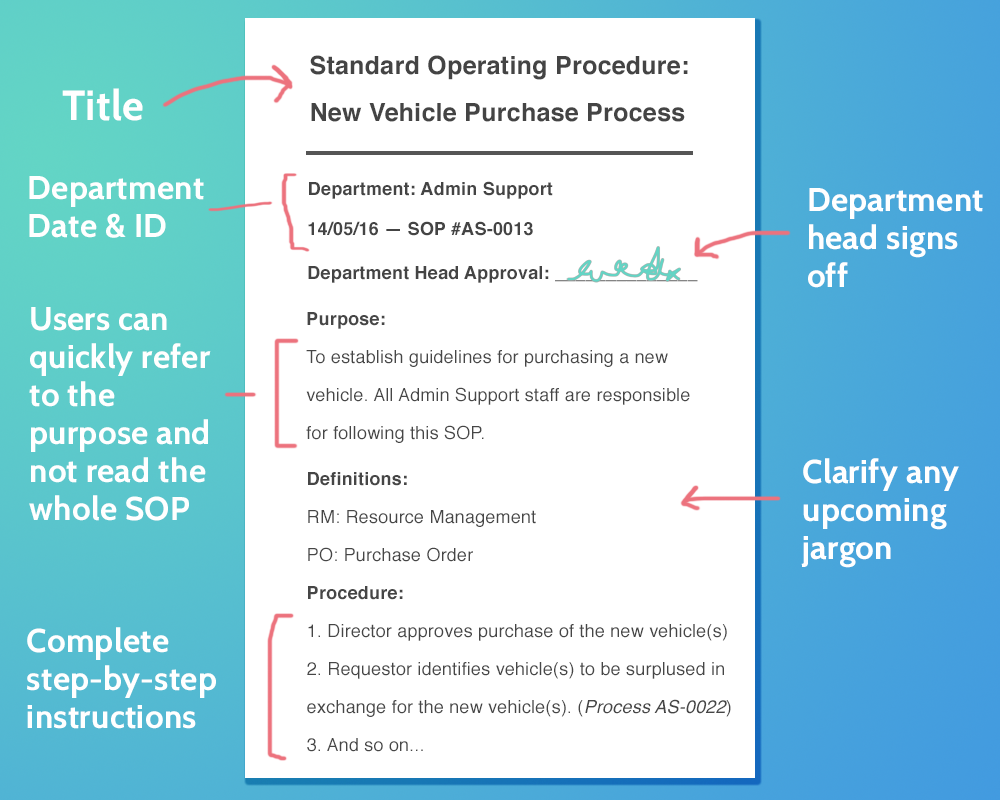
Properly implemented BPM allows you to:
- Increase revenue;
- Reduce costs;
- Achieve compliance;
- Mitigate risks;
- Improve productivity;
- Improve business user satisfaction;
- Gain competitive advantage;
- See real-time analytics;
- Change and scale your processes with agility.
BPM in practice: How to use it
In practice, the application of BPM can be broken down into the following sections:
- Process discovery;
- Process creation;
- Process implementation;
- Process analysis;
- Process improvement.
There are many different ways to do each of the steps listed above, but I have attempted to present an overview of a wide range of proven methods for you to select from.
The following sections will unpack various different approaches to each of the steps above, along the way to a full implementation of BPM.
If you want to investigate further into a particular method, links will be provided for more in-depth reading in their respective sections.
Process discovery
The first step, once you’ve decided you want to utilize BPM, is to figure out what processes you’re already using within your company.
Once such technique for process discovery is known as process mining, which is basically a data driven way to create, understand, and optimize your processes.
Process creation
Record the steps of your process.
How you do this doesn’t matter in principle. You can do this on paper with notes as you go from step to step or task to task, if you want.
But, if you want to save yourself the time and make it easier for yourself and anyone else who will need to interact with the process in the future, you might want to consider creating a template in Process Street.
Here are some informal guidelines (tried and tested by us at Process Street) for process creation, to ensure you get the most out of your processes, with a focus on usability and clarity from the start.
Golden guidelines for process creation
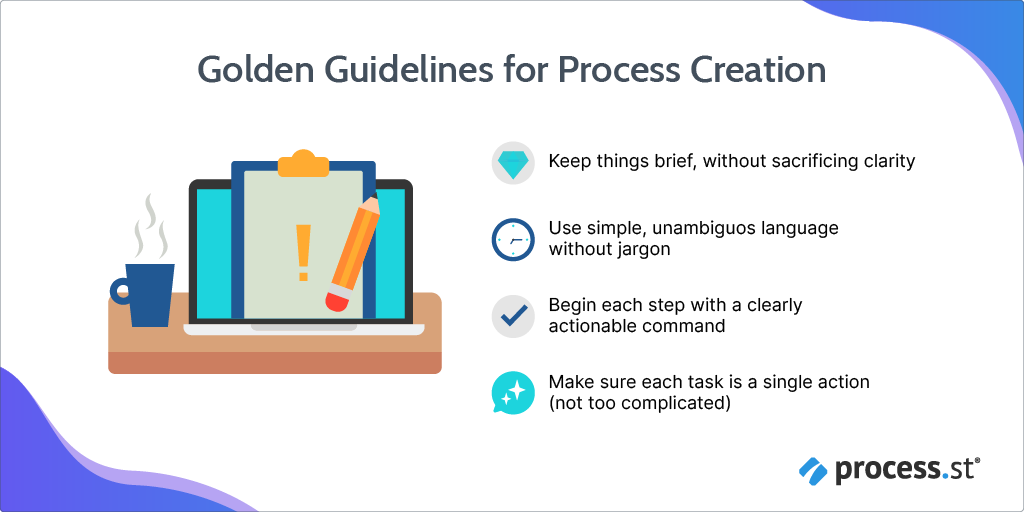
When you’re writing processes, consider these guidelines as best practices:
- Keep things brief, without sacrificing clarity.
- Use simple, unambiguous language without jargon.
- Begin each step with a clearly actionable command.
- Make sure each task is a single action (not too complicated).
Below are 16 more specific steps that can function as guidelines for writing your processes. Originally tailored for ISO 9001 standard framework, they are just as well-suited to writing processes for BPM:
- Understand how you will present your SOPs.
- Gather the relevant stakeholders.
- Work out your purpose.
- Determine the structure of your process.
- Prepare the scope of the procedure.
- Use a consistent style.
- Use correct notation, if applicable.
- Work through all the necessary steps of the process.
- Try to assess potential problems in the process.
- Determine metrics against which SOPs can be judged.
- Test the process.
- Send the process to superiors.
- Clarify the method of optimizing the process.
- Run a risk assessment on the process.
- Consider creating a flow diagram.
- Finalize and implement the SOPs.
For a more in-depth look at each of these steps, check out this article on writing standard operating procedures.
Agile vs Waterfall: Overview
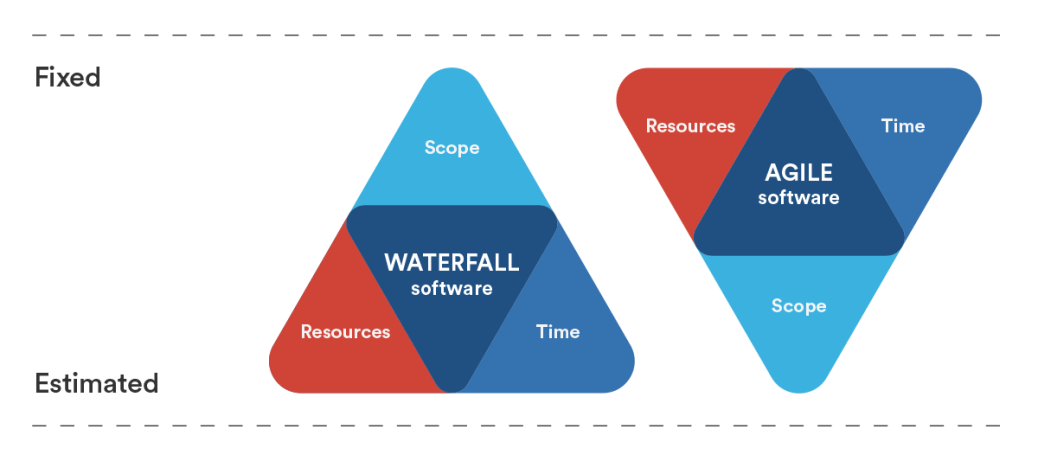
Waterfall is known as the “traditional” approach, and it’s all about taking things slow and steady.
Under the Waterfall methodology, you’re minimizing risk, and aiming for one big outcome at the end – the result of careful planning of each and every task in all of your processes.
Agile, meanwhile, is all about getting things done, fast. You’ll be prioritizing hitting those quick check marks throughout a project. This approach encourages iteration and experimentation, with a focus on a quick delivery of your product. Under the Agile methodology, you’ll be learning a lot from trial and error, relying on customer involvement.
Process implementation
Implementing processes is all about getting a process to the point where it’s actionable, and then acting it out.
How to enforce processes
Here are some common problems faced when trying to enforce processes:
- Making sure processes are followed in the right order;
- Making sure processes are followed within a specific time frame;
- Making sure tasks are assigned to the right people;
- Making sure certain information is collected at certain parts of a process.
A big difficulty with process implementation is making sure processes are followed properly. If you have a process where a certain task needs to be completed within a specific time frame, how do you enforce that? BPM software makes it easy to ensure processes are implemented properly.
For example, in Process Street, stop tasks can be set on certain tasks to make sure a process is followed in a specific order.
By the same principle, dynamic due dates ensure tasks are completed within very specific and customizable time-frames. You can have dynamic due dates activate based on very specific criteria, such as only when the task before has been completed, or based on the start of the checklist, etc. All of these features serve to enforce processes the way they were supposed to be followed, and help minimize things like process failure and human error.
Increasing buy-in from your team
A surefire way to increase team buy-in is to involve everyone on the team in the implementation process. Start simple and try out early iterations of a process as a team, and figure out what works (and what doesn’t).
There is of course more to it than just this.
Streamlining processes, and eliminating tedious work which doesn’t feel valuable can greatly contribute not only to company morale, but the widespread adoption of processes throughout the workplace.
This might take the form of a clearly actionable process, one that can involve assigning tasks to other team members, putting stop tasks in place to enforce actions, or using conditional logic to build flexible complex processes, keep sales reps on track even when circumstances or scenarios have more variables.
As Process Street CEO Vinay Patankar points out in this webinar on building a scalable sales process, one of the most effective ways to get reps to follow a process is to make it easier and better for them to follow it than not. This comes down to good process design over time as you iterate.
He points out that sales reps typically only spend 32% of their time selling! The rest is often spent on admin:
“If you can reduce the amount of admin that a rep has to do to complete that same process, they’re much more likely to adopt it and keep using it.” – Vinay Patankar, CEO at Process Street
If you want to really dig deep into automating administration tasks and letting your sales reps focus on what they do best, then check out our ebook: The Ultimate Guide to Business Process Automation.
Process-oriented culture
The idea of a process-oriented culture is not something exclusive to process implementation; it underlies all stages of the BPM approach.
However, it is specifically important for process implementation and improvement.
Process implementation and improvement requires right kind of organizational culture to support it. Here are few key ingredients that you can consider while building your organization for better process improvement results:
- Focus on the customer.
- Utilize data to drive BPM.
- Facilitate a culture of collaboration.
- Prioritize problem prevention over after-the-fact problem solving.
- Create an atmosphere which strives for perfection, but tolerates (and makes the most of) failure.
A company’s culture is the sum of its attitudes, policies, and personality. Some companies are strict, some allow for more leniency. Some depend on rigid hierarchies with many levels of management, while others encourage transparency and open communication between departments and positions. Workplace culture sets the tone for the work done, and can have a massive impact on productivity and happiness.
Adopting a process-oriented culture can also help to build employee accountability.
That’s because empowering your team to modify or create the processes they use gives a sense of ownership.
According to Harvard Business School Professor Francesca Gino:
“Giving [employees] ownership of ideas, a team of people, or a product can dramatically improve their sense of engagement in and happiness with their jobs, and their productivity as well”.
By collaborating with your team to develop processes based on their tested methods, you’re both helping to improve your team’s consistency and giving them ownership over the way they work.
Process analysis
Process analysis is all about making sure things are happening as they should be.
This often involves taking a look at what has been achieved or not based on processes used, for example in a monthly review meeting, or using techniques like process modeling to build a high-level overview of process usage and effectiveness.
It’s a kind of problem solving, which always keeps key business goals in mind. Figuring out why certain goals haven’t been achieved, or why certain metrics were lower than expected.
Let’s look at a few techniques for process analysis.
Using business process mining for analysis
Another application of process mining is utilizing it for analysis; understanding how well a process is constructed and how well people are using it.
This relies on event logs collected during standard process mining techniques.
We can see from event logs certain information like how long it has taken a person to do a specific task. Perhaps it’s clear from looking at this that certain tasks could be done more quickly? Identifying the potential inefficiency within the log can lead you to go-see (genchi genbutsu) the potential inefficiency in real life to investigate and see whether it can be improved.
That’s a simple example, but the complexity of analysis you can go into depends largely on how much time and effort you want to put into analysis and the depth of data you can gather.
Check out our article on process mining for more details.
The 5 Whys
The 5 Whys is a technique used to better understand the cause-and-effect relationship of any given problem. It essentially relies on repeating the question “Why?” to figure out the root cause of a problem or defect.
Let’s look at an example.
Imagine a vehicle that won’t start (this is the problem we’re trying to solve).
- Why? – The battery is dead. (First why)
- Why? – The alternator is not functioning. (Second why)
- Why? – The alternator belt has broken. (Third why)
- Why? – The alternator belt was well beyond its useful service life and not replaced. (Fourth why)
- Why? – The vehicle was not maintained according to the recommended service schedule. (Fifth why, a root cause)
In theory you can continue questioning to a sixth, seventh, or higher level, but five iterations is usually good enough. It’s important that the person asking the question avoids making assumptions and logic fallacy, and instead makes sure to diligently trace the chain of causality in clear, direct increments, one step at a time, from an effect to a root cause that still has some connection to the original problem.
Process mapping vs process modeling
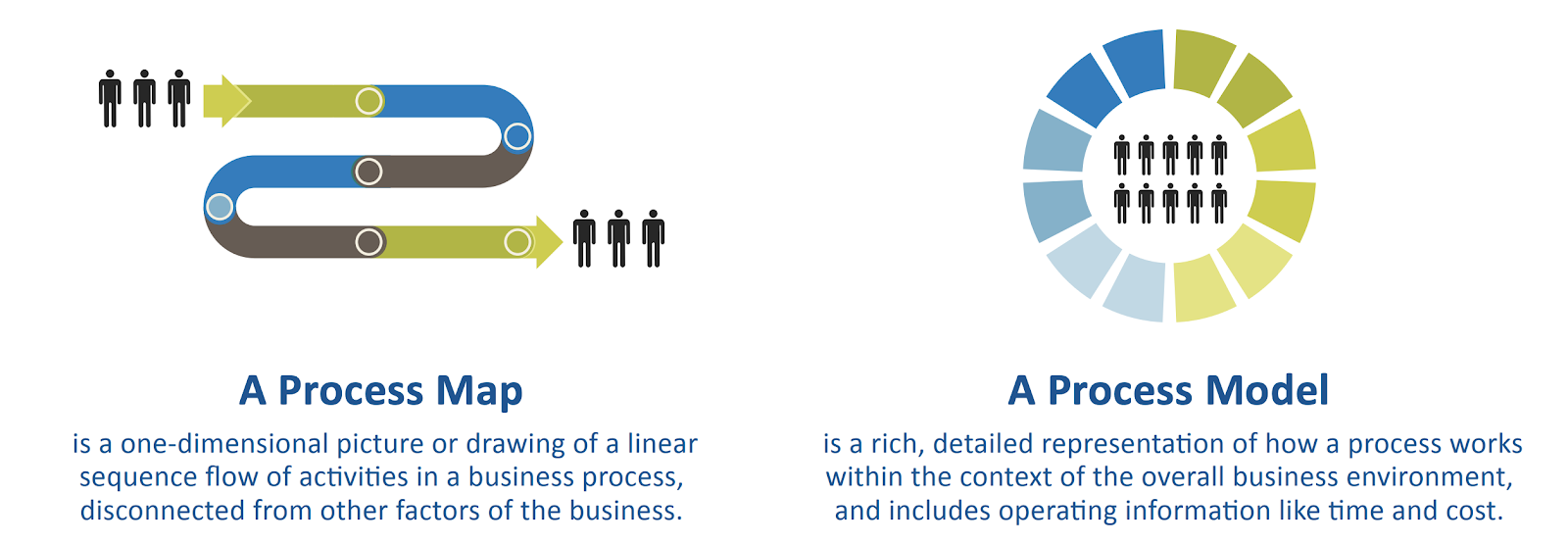
What’s the difference? Well, you could say that process models are an extension of process maps, often “enhanced” in some way.
All that means is that process models are often created using software, enabling it to contain rich operational data, details regarding relationships to business goals, and adapt to change dynamically through various software integrations.
The software used for process modeling is categorized as BPMN and UML. We have written in-depth tutorials for both of these options which you can access by clicking their respective links.
A process map, on the other hand, represents a static, linear sequence flow of tasks that aren’t necessarily concerned about other business processes or the environment as a whole, focusing instead on only one particular flow of activities. Think of it as a snapshot of how a process is currently executed, like a balance sheet is a snapshot of a company’s financial health.
Process monitoring and tracking
It doesn’t matter if you’re using the most efficient software on the market, have an amazing team, or are taking every step to ensure you’re documenting and improving your methods to smooth out all the rough edges and smash those bottlenecks – you’ll still fail if you can’t track your processes.
Monitoring and tracking your processes is the only way to know for sure that your methods are being followed, that work really is being completed, and to have a clear view of the state of your business at any given time.
Process improvement
Now that you’ve built out your process you can move forward to improve it.
To improve the processes, explain to the teams who use them what your aims are in advance. This way, the team can be thinking about possible improvements as they follow the process.
It is important to make sure your processes are thorough but not overbearing.
Improving processes is all about figuring out how to make sure the process is doing what it should be doing: advancing your business goals.
Assuming your processes are aligned with your business goals, there are a few simple steps you can follow to quickly start improving your processes as a small business or startup.
Five actionable steps for process improvement
- Run the process. Use the process even if it is very simple.
- Identify the essential parts of the process and eliminate non-essential tasks
- Each time you use the process, think of one or two things you could improve.
- Spend no more than 5 minutes each time improving the process. Let it improve gradually and iteratively.
- Automate repetitive manual tasks
This is a rough, informal methodology to get you started with process improvement. The most important thing is to start using your processes with the intent to understand how they work better, and ultimately improve them.
The process for improving a process
Here is a detailed process for optimizing a process:
This particular template was built out as an example for our policy and procedure template article.
Process automation
Imagine that about half of the work in your business could be automated.
Now imagine if you could cut operating costs by up to 90%.
Both of these things are possible, and BPM software is the first step, swiftly followed by setting up a framework for automation to enable processes to run as smoothly as possible.
It doesn’t matter whether you’re using Asana, Salesforce, Trello, or MailChimp, every app has processes which can be automated to cut down on the amount of time you spend on menial tasks that are taking the focus away from your main business goals.
Automation and productivity go hand-in-hand, as you are minimizing the waste in time and resources that the original, manually-intensive process contained.
If you haven’t already, check out our Ultimate Guide to Business Process Automation for all you need to know about applying automation to the processes you’ve built or are currently building.
Glossary of BPM terms
BPMS
There’s an “S” that you’ll sometimes see on the end of BPM. The “S” in BPMS stands for “Suite.” A BPMS is the suite of BPM technologies — including all the functional modules, technical capabilities, and supporting infrastructure — integrated into a single environment that performs all the BPM technology functions seamlessly. A BPMS is the total package.
iBPM
iBPM, also known as Intelligent Business Process Management, is basically using artificial intelligence (AI) techniques to enrich existing BPM tools and methodologies.
The differences between BPM software and iBPM software is chiefly in the “intelligent” designation, but in practice this is very little, as one is the extension of the latter. BPM is a tool used for designing and executing business processes, whereas iBPM is just a subcategory of BPM that leverages a BPM’s analytics and intelligence capabilities.
BPN
Business process networks (BPN), also known as business service networks or business process hubs, enable the efficient execution of multi-enterprise operational processes, including supply chain planning and execution.
To do these things, BPNs make heavy use of integration with applications in order to support a particular industry or process, such as order management, logistics management, or automated shipping and receiving.
RPA
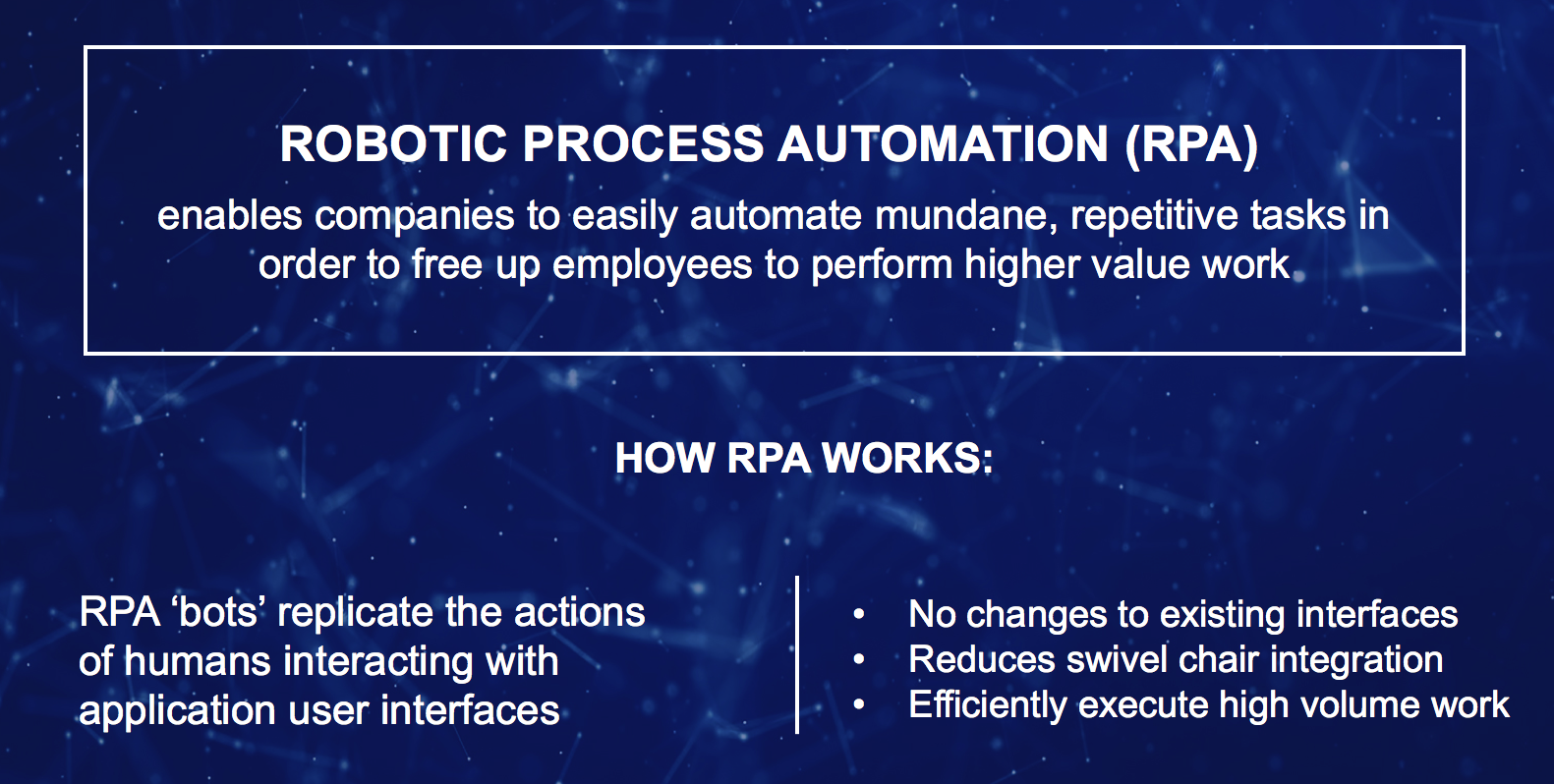
Robotic process automation is an application of technology, governed by business logic and structured inputs, with the end goal of automating business processes.
Using RPA tools, a company can configure software (or “robot”) to capture and interpret applications for processing a transaction, manipulating data, triggering responses and communicating with other digital systems.
RPA scenarios might range from something so simple as generating an automatic email response to the deployment of thousands of bots programmed to automate jobs in an ERP system.
HPaPaaS
HPaPaaS refers to rapid application development platforms which provide business developers with the tools to build enterprise applications rapidly and which are offered as a service with one button deployment and other composite capabilities.
It stands for High Performance Application Platform-as-a-Service.
ABPD
Automated Business Process Discovery (ABPD) is a specific kind of heavily automated business process analysis that is heavily dependant on algorithmic and computational logic building.
The principle of ABPD is that similar types of business analysis tools automatically gather data from documents such as audits and event logs, and compile it into useful information that is able to identifies process models while also exploring variations, giving users a much better picture of what a specific business process looks like, and how changes would affect the business as a whole.
Automated Business Process Discovery is also known as process mining. However, in academic literature the term Automated Business Process Discovery is used in a narrower sense to refer specifically to techniques that take as input an event log and produce as output a business process model.
Business Process Conformance Checking ( BPCC)
Business process conformance checking (a.k.a. conformance checking for short) is a family of process mining techniques to compare a process model with an event log of the same process.
Hence, conformance checking may be used to detect, locate and explain deviations, and to measure the severity of these deviations.
Business Process Performance Analysis (BPPA)
Business process performance analysis is the foundation of any business process optimization initiative. Tools for business process performance analysis enable timely determination of business process breaks and malfunctioning.
Business process analysis starts with definition of measurable parameters that have to be monitored and managed. Also Key Performance Indicators (KPIs) should be defined to be tracked on a regular basis.
Process mining
Process mining is a group of systems in the field of process management that help the investigation of business processes by utilizing information gleaned from event logs.
During process mining, data mining calculations are connected to event log information so as to distinguish patterns, examples and subtleties contained in event logs recorded by a data framework. The goal of process mining is to improve process effectiveness and better understand how processes work.
The term Process Mining is used more broadly to allude any kind of process for finding process models within a given system, but as well to refer to strategies for business process conformance and performance analysis based on event log information.
Continuous improvement
Continuous improvement principles for business process management focus on incremental enhancements to optimize efficiency and effectiveness. Key principles include regular process evaluation, stakeholder involvement, and data-driven decision-making.
By employing techniques such as Lean, Six Sigma, and Kaizen, businesses can identify and eliminate waste, reduce variability, and enhance quality. Continuous feedback loops and performance monitoring ensure ongoing refinement, fostering a culture of adaptability and innovation.
This approach helps organizations remain competitive and responsive to changing market conditions and customer needs.
BPMN
You can think of Business Process Model & Notation (BPMN) as a flow chart on steroids.
It’s pretty much the one reliable way to graphically map your processes, while being a globally-recognized, standardized method. In other words, it’s information any business looking to draw dependable process maps needs to know.
When you map your processes (especially with a standardized method like BPMN), you start being able to:
- Get a clear vision of exactly how everything in your business works.
- Save time by eliminating unnecessary tasks.
- Reduce the rate your employees forget, overlook, or wrongly execute work.
BPMN lanes & pools
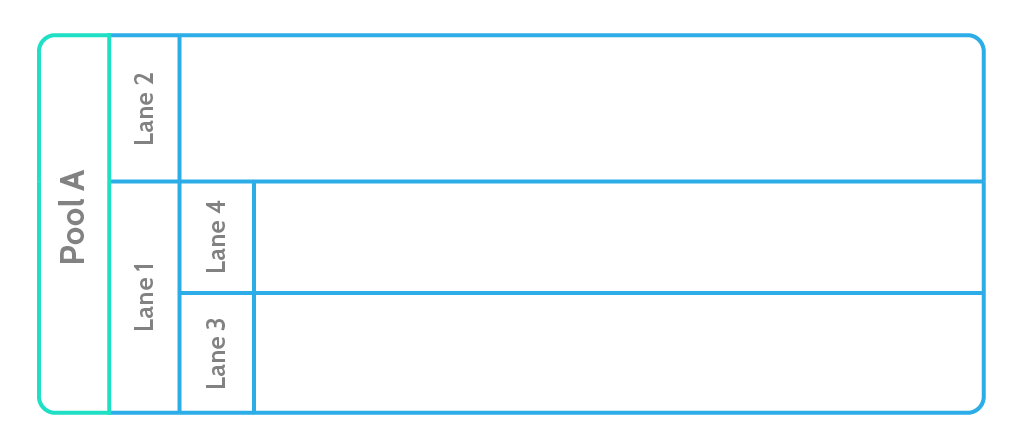
Pools represent different organizations or entirely separate processes. Lanes represent different teams or individuals within the same organization.
BPMN notation
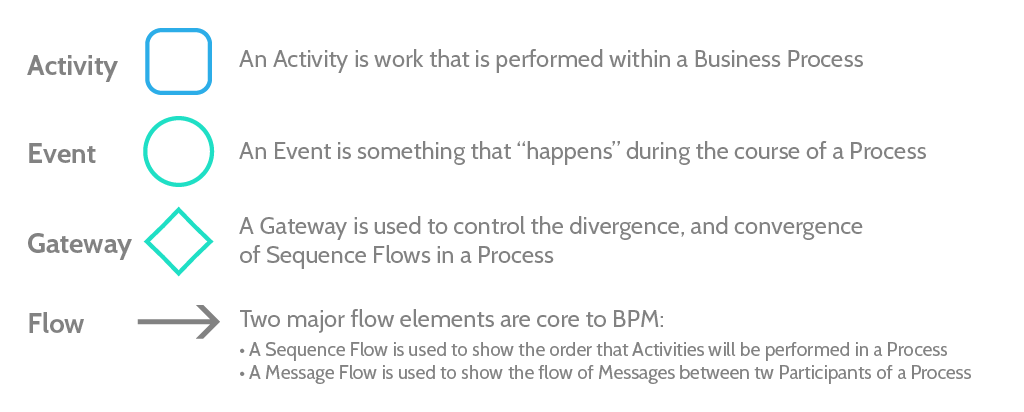
- Activity: Represents tasks
- Event: Represents work done during a process
- Gateway: Deals with logic and decisions
- Flow: Represents the order which activities are completed
BPMN flow

Sequence flow the basic line that connects together elements of your map. It shows the flow of work, and is necessary for connecting together activities. Without a sequence flow, your map is invalid.
Message flow is used when different departments or organizations send information between one other. Since you don’t get up and go and oversee the work in different departments when you want a task done, message flow represents a request or the sharing of information, not a strict action. It’s the only kind of flow that can take place between pools or lanes (organizations or departments).
Documents, databases, and other elements are tied together with activities. For example, if you had an activity to sign off on a purchase order, you could use a document symbol and an association line to link the two together.
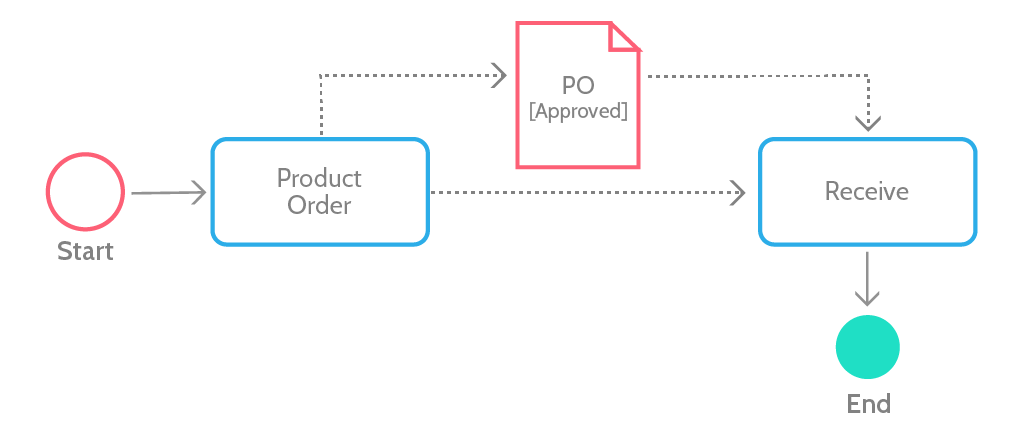
BPMN gateways

Similar to diamonds in regular flow charts, gateways represent a split or convergence in the process chart.
For example, when deciding on what to eat, the process will split depending on the final meal choice, but will converge at the point where the meal is eaten, because no matter which meal is chosen, it will eventually be eaten.
BPMN event gateways
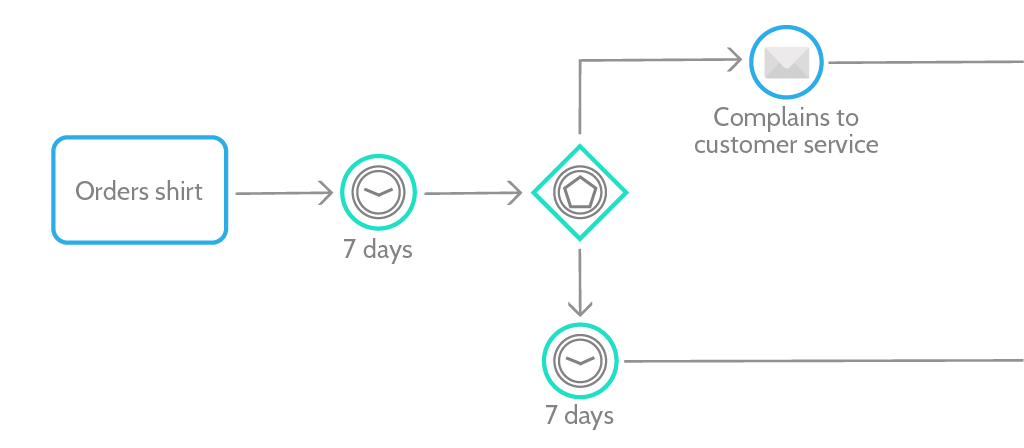
But, not all event gateways represent choices.
It could be that the process needs more data in order to proceed, or it may be waiting for a specific time, or some other condition to fulfil. In that case, it’s represented as an event gateway, and branches into whichever event takes place next.
For example, if you’re waiting for over a week for your delivery to come, you might reach a point where you decide whether to wait patiently, or call the shipping company. You’d have an event-based gateway at that point, branching into waiting more time, or into calling.
BPMN parallel gateways

If two tasks aren’t dependent on one another, best practice principles of efficiency state that they should be allowed to be started and completed in parallel.
To represent this on a BPMN map, a parallel gateway is used.
All that means is that there is now a chance for both subsequent tasks to be started: the process breaks down into two parallel branches.
BPMN exclusive gateways
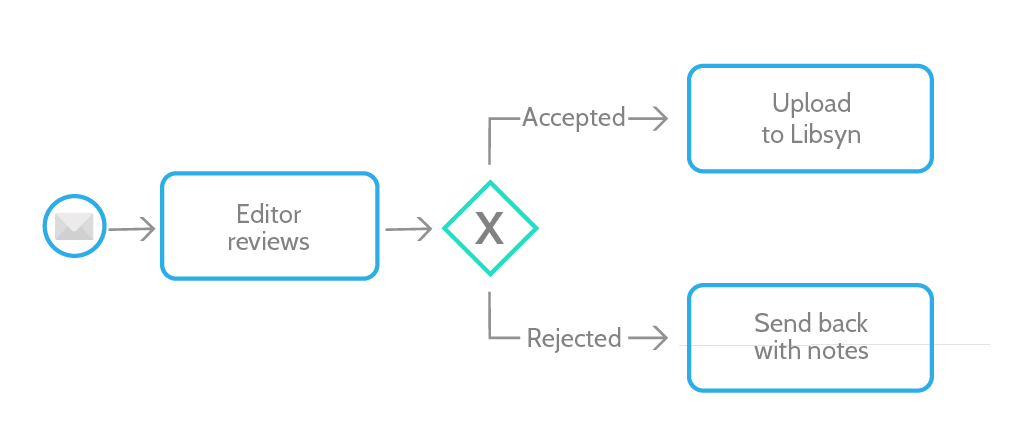
Sometimes, processes are limited by their design. Or rather, they can go only one of two (or any number of) ways.
Another way to explain this is to imagine a podcast recording. Either the recording is accepted and moves onto the editing stage, or it’s rejected and moves back to the editor for another pass.
This is an example of an exclusive gateway in action — because there’s no third option in this case.
BPMN inclusive gateways
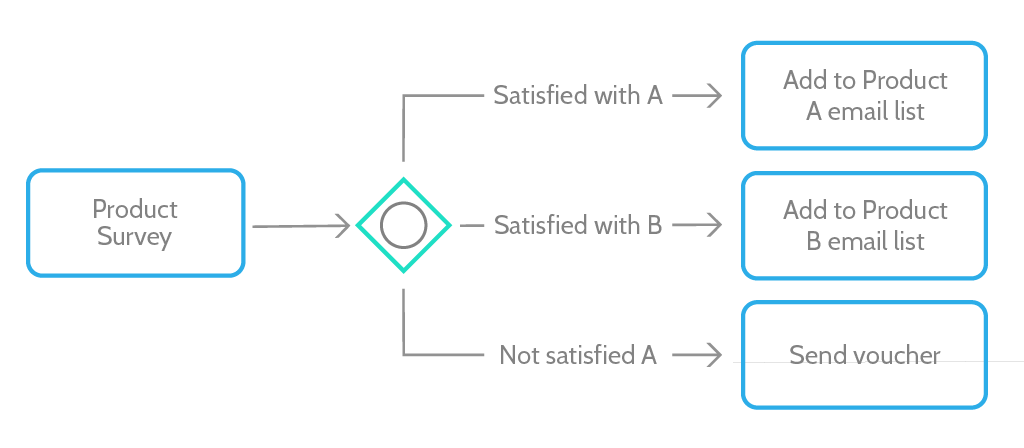
One way to understand inclusive gateways is by thinking about them as processes that fork based on a specific customer’s response to a survey. LucidChart explains:
“One process is triggered if the consumer is satisfied with product A. Another flow is triggered when the consumer indicates that they are satisfied with product B. A third process is triggered if they aren’t satisfied with A. There will be a minimal flow of one and a max of two.”
Inclusive gateways mean that multiple possible outcomes can be selected. E.g. one of your customers could be both ‘dissatisfied with A’ and ‘satisfied with B’, and in that case they’d be sent the voucher and also get added onto the B list.
UML
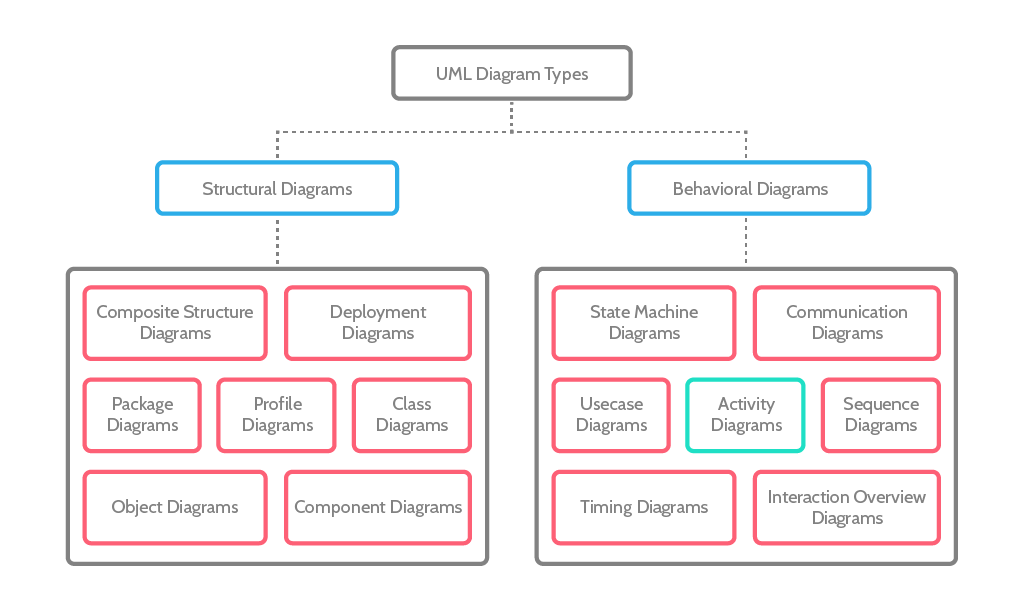
In simple terms, Universal Modeling Language (UML) is a framework for visualizing software program structures through diagrams.
More specifically, it was created to forge a common, semantically and syntactically rich visual modeling language for the architecture, design, and implementation of complex software systems both structurally and behaviorally.
It was not originally designed to model business processes, and therefore its application in BPM is significantly limited in how complicated it can be in comparison to its application in software engineering or development.
UML Structural diagrams
Structural diagrams are designed to represent static components of a software system. They are focused on the system’s underlying structure. The 4 main types of structural diagrams are:
-
- Class Diagram
- Object Diagram
- Component Diagram
- Deployment Diagram
</ol
The class diagram is by far the most commonly used of the four listed above. From a software development perspective, it is one of the most useful UML diagram types because it clearly maps out the structure of a system by modeling its classes, attributes, operations, and relationships between objects.
In other words, it holds the ability to provide both detailed insight and a quick, big-picture overview of a system’s structure, making it the foundation for creating systems.
UML behavioral diagrams
Behavioral diagrams, on the other hand, visualize, specify, construct, and document the dynamic aspects of a system.
The most commonly used behavioral diagrams are:
-
-
- Use Case Diagram
- Sequence Diagram
- Activity Diagram
-
Use case diagrams are designed to show how users might interact with a system. Users include people, organizations, or external systems.
Diagrams displaying certain use cases are not intended to be complicated; they’re supposed to give a clear picture of how users are interacting with a particular system and whether or not those interactions are happening as intended.
Sequence diagrams are used to illustrate how objects or tasks communicate and interrelate, and in what sequential order. They are one of the most commonly used interaction diagrams.
Activity diagrams are popular as well, and are ideal for modeling business processes because they are the only type of UML diagram that accounts for the flow of actions.
How Process Street can help you with BPM
Create processes in seconds
Process Street was designed to be easy to use. Everyone is a process owner! You can create new processes in literally a matter of seconds, with no prior training or experience.
This applies to updating and improving processes, too.
Utilize rich content and media
With form fields and the wide range of rich content and media you can include in your checklist templates, you can design processes that are clearly actionable, informative, and able to collect extensive data as they’re being followed.
Schedule tasks
Use Process Street’s dynamic due dates feature to set times for certain tasks to be completed, increasing adherence and making sure processes are working for you.
Keep track of your processes
With Process Street’s Template Overview and Inbox features, you’ll never have to worry about losing track of work done again.
Control permissions and delegate work
Task Assignments allow you to assign certain tasks in a process to appropriate personnel in your organization, streamlining the process and saving time in what would otherwise be a time consuming manual process.
Easily share your processes
You can share direct links to your processes, embed them in a HTML widget, and provide read or write access all from the Process Street interface.
Controlling access to your processes is good BPM practice, as it means you can facilitate a culture of accountability as well as collaboration and transparent communication.
Those final points also tie into the next:
Designed for collaboration and communication
Quickly and easily collaborate on processes with others in your organization by sharing and editing processes. A dedicated comments framework means you can provide and receive feedback on checklists and templates with anyone you grant access to (assuming they have a free Process Street account).
Create flexible processes
Using conditional logic, you can make your processes truly robust and ultimately flexible. Certain tasks will be able to be hidden or shown based on conditions met as the checklist is worked through.
You have free reign to design processes with as much complexity as you need, and it’s designed with absolute ease of use in mind.
And most importantly, Process Street’s conditional logic is seamless, so those running your processes won’t have to think twice about it.
Introductory webinar
Check out this introductory webinar for a hands-on look at using Process Street for your BPM needs:
How to automate your BPM with Process Street
It should be said that process management ≠ process automation.
Despite the fact that it’s often true that automated processes are more efficient, some tasks are just better off done manually. Computers can make errors too, and we lack one thing that they’ll never have (for now, at least): common sense.
Again, it’s something to test out for yourself and think properly about. While you figure out the best way to implement BPM, I’d suggest checking out our ebooks on business process automation and management:
This article covered a lot of ground, and I hope you found something useful in there somewhere. Because of the scope of this article, I tried to keep it to the most crucial information. Do you think anything needs revising, or perhaps you have additional insight you’d like to share? Let me know in the comments!







 Workflows
Workflows Projects
Projects Data Sets
Data Sets Forms
Forms Pages
Pages Automations
Automations Analytics
Analytics Apps
Apps Integrations
Integrations
 Property management
Property management
 Human resources
Human resources
 Customer management
Customer management
 Information technology
Information technology



Oliver Peterson
Oliver Peterson is a content writer for Process Street with an interest in systems and processes, attempting to use them as tools for taking apart problems and gaining insight into building robust, lasting solutions.